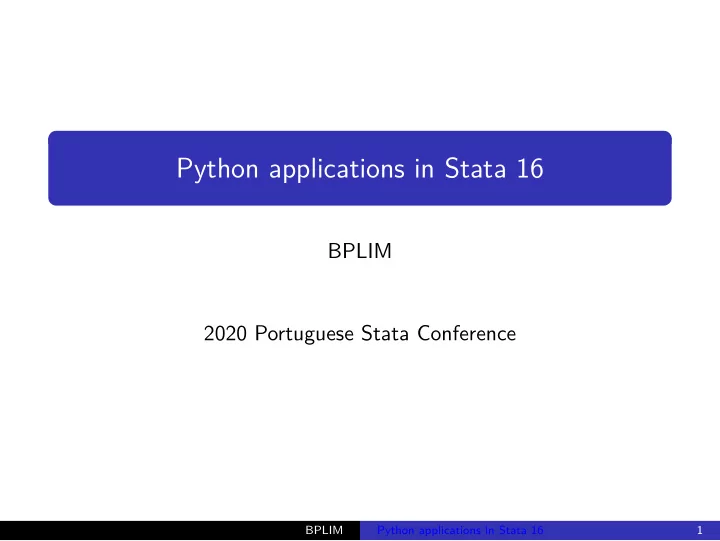

Python applications in Stata 16 BPLIM 2020 Portuguese Stata Conference BPLIM Python applications in Stata 16 1
Introduction Stata 16 has been recently released and one of its new features is the ability to embed and execute Python code from within Stata This requires that Python is installed in your computer. Stata will search for Python installations on the system and choose the one with the most recent version You can use Python interactively (just like Mata) and embed Python code in do-files and ado-files In this presentation, we show two examples of ado-files with Python code: adrcheck ineuse BPLIM Python applications in Stata 16 2
adrcheck This command gets suggestions for addresses stored in a Stata variable by going to Google Maps and returning the first suggestion for each observation. The current version only supports interface with Google Chrome. The suggestions from Google Maps are stored in the variable _msug. BPLIM Python applications in Stata 16 3
adrcheck Syntax adrcheck var, [options] The help file lists all the options available. Dependencies Python 3.4+ Selenium Selenium requires a driver to interface with Chrome. To run the code, you will need to install ChromeDriver and specify the path to the executable file in the option execpath . BPLIM Python applications in Stata 16 4
adrcheck Limitations / Future developments The current version only supports the interface with Google Chrome, but we intend to extend it to other browsers Generalize the command to work with any string (not just addresses) and use Google to get suggestions BPLIM Python applications in Stata 16 5
ineuse This package allows users to interface with Statistics Portugal’s (INE) API, to import data from a vast list of indicators directly into Stata. It includes two ado-files: command version: ineuse allows the user to programmatically import and save data for more than one indicator. To run ineuse , the user must specify the code of the indicator(s). All the information available for that indicator(s) will be imported. menu version: inedlg launches a menu that allows the user to choose an indicator and select the levels for a particular dimension(s) of the indicator. The data is available in English and Portuguese. BPLIM Python applications in Stata 16 6
ineuse ineuse Syntax ineuse code, [en] Dependencies Python 3.5+ requests, pandas BPLIM Python applications in Stata 16 7
ineuse inedlg Syntax inedlg Dependencies Python 3.5+ requests, pandas, ttkthemes Ancillary files Indicadores_en.csv, Indicadores_pt.csv BPLIM Python applications in Stata 16 8
ineuse Limitations INE’s API, in its current state, does not allow users to specify more than one level for a dimension(s) in the script. In order to import all available data for one indicator or for multiple levels of a dimension(s), the user must call the script multiple times in a loop. This slows the process of importing data (specially when importing monthly data for all available periods) and may even result in INE blocking the request because of multiple calls made to the API. BPLIM Python applications in Stata 16 9
Thank you for your attention BPLIM Python applications in Stata 16 10
Recommend
More recommend